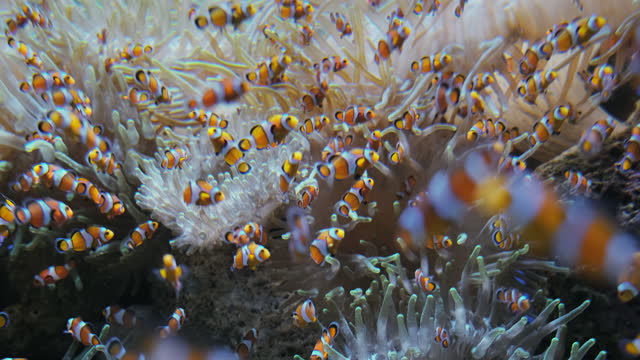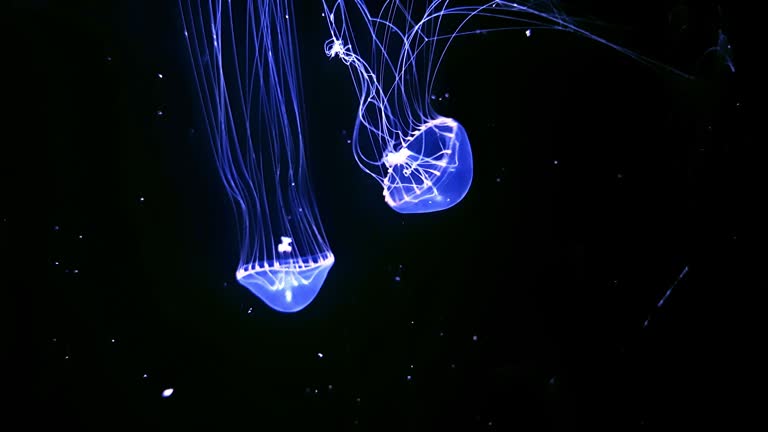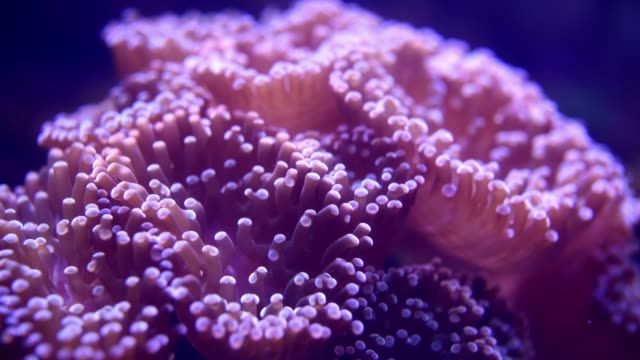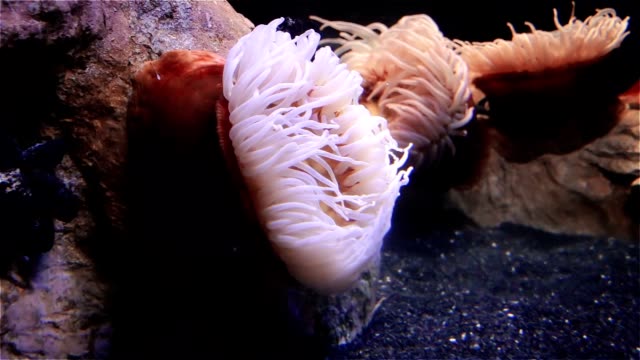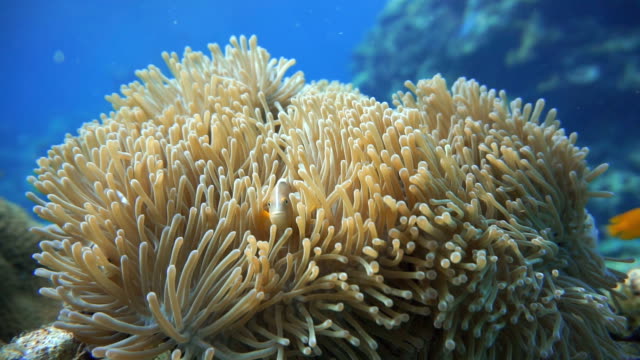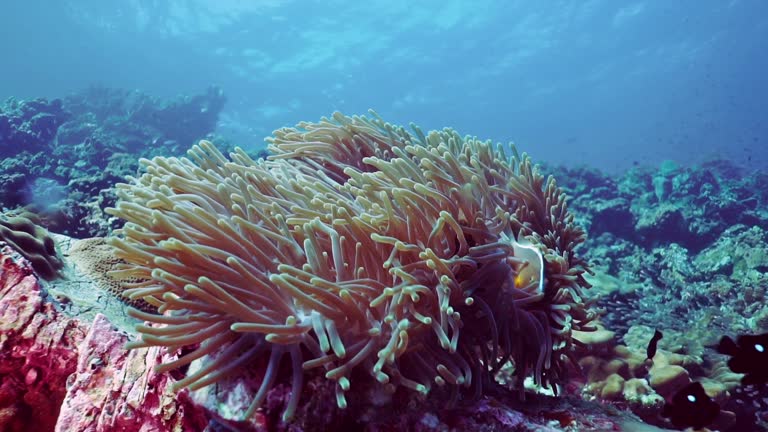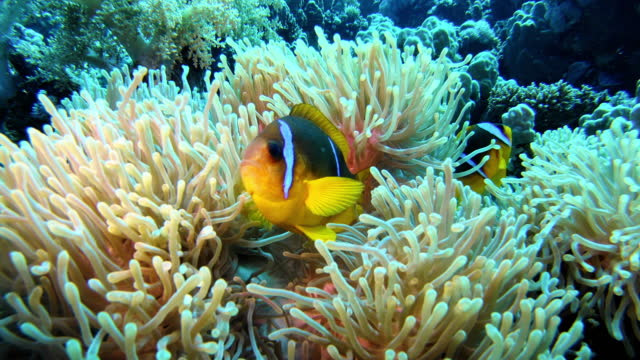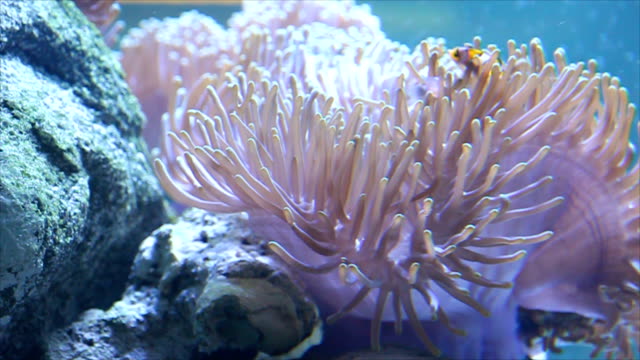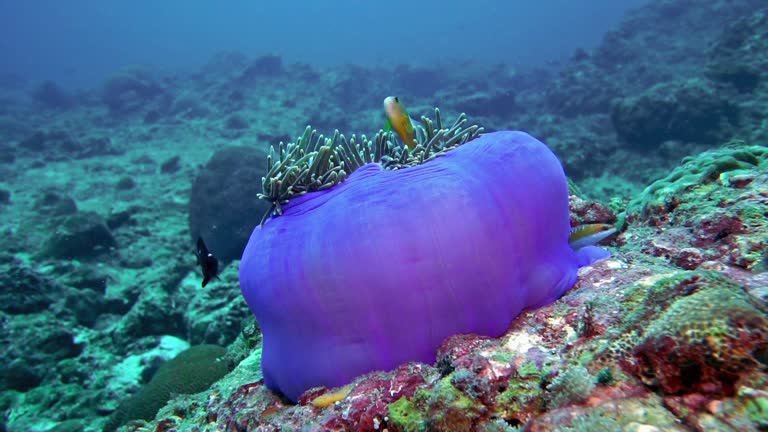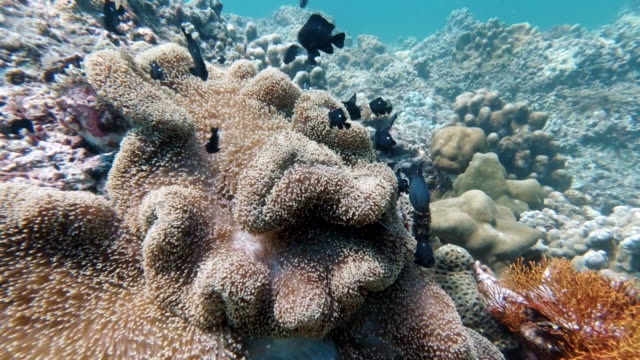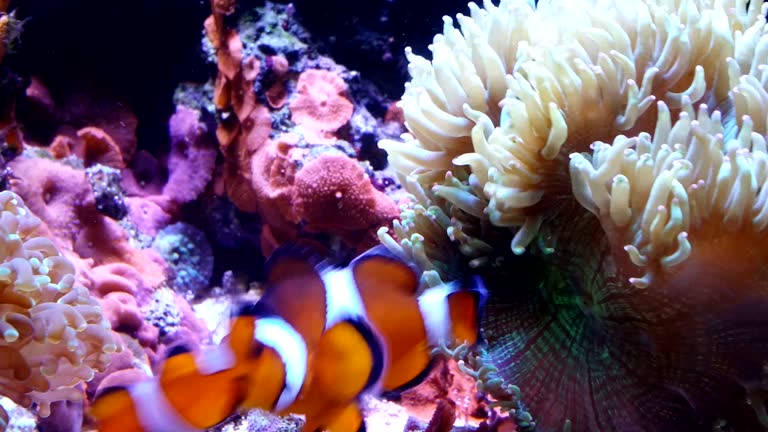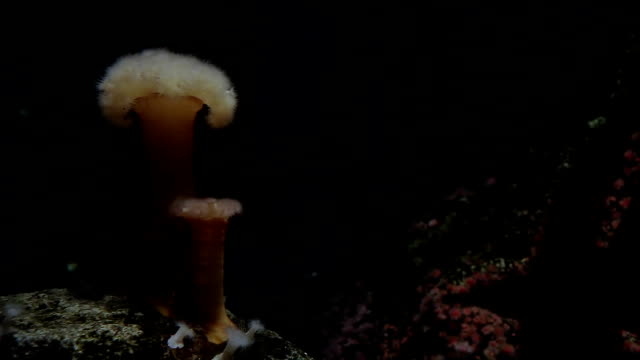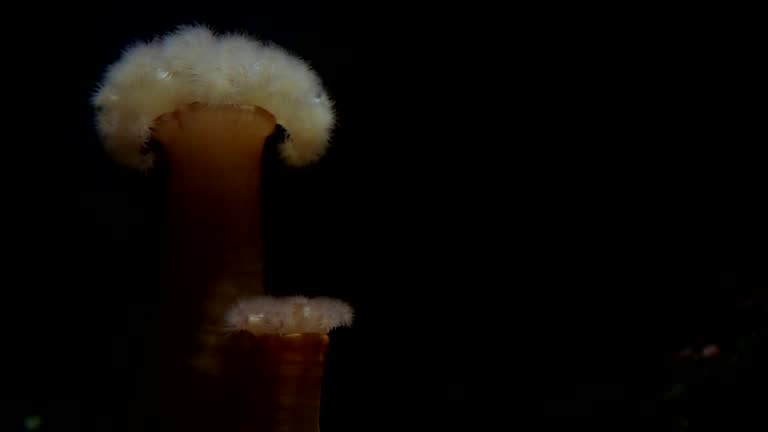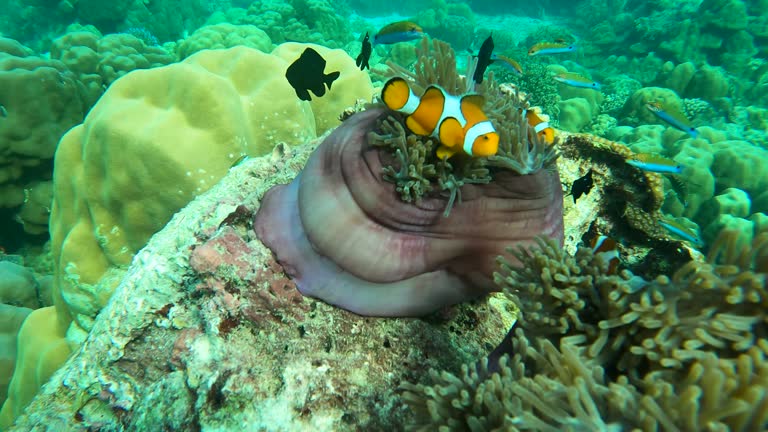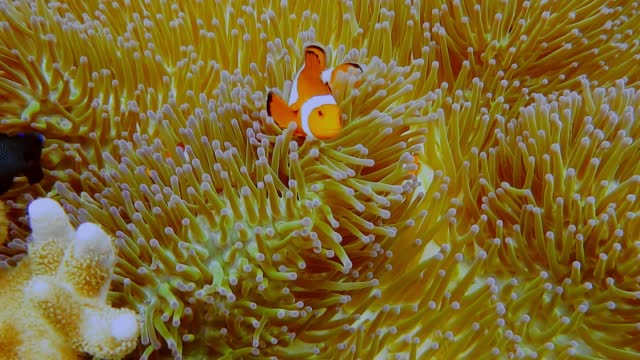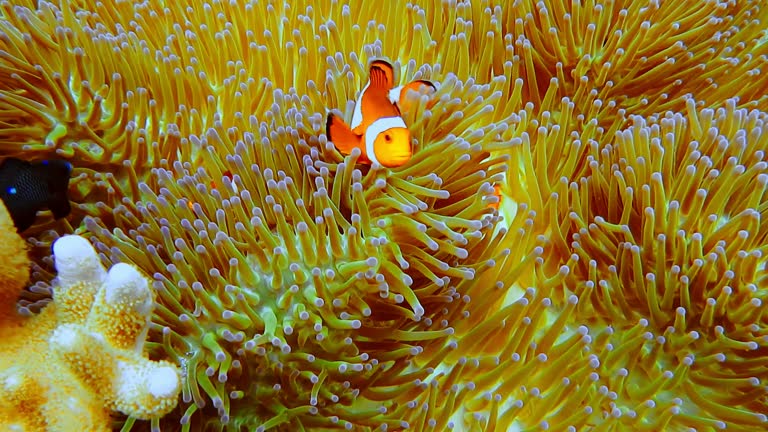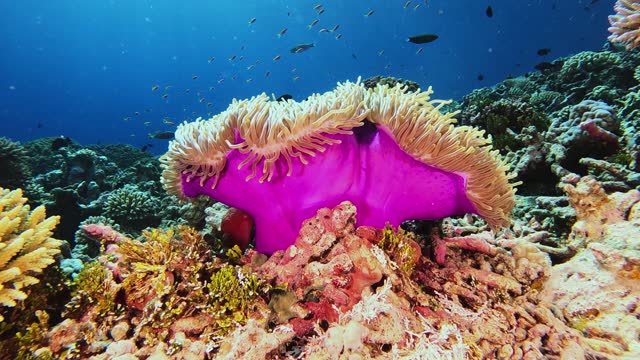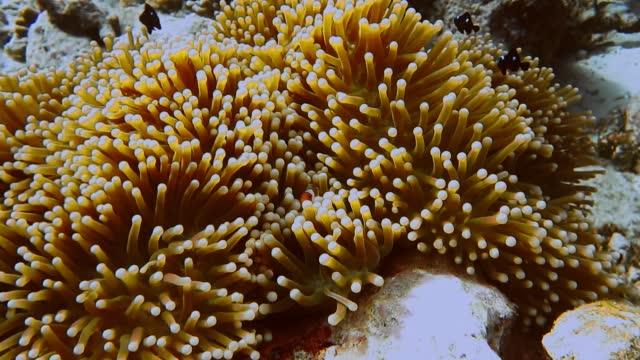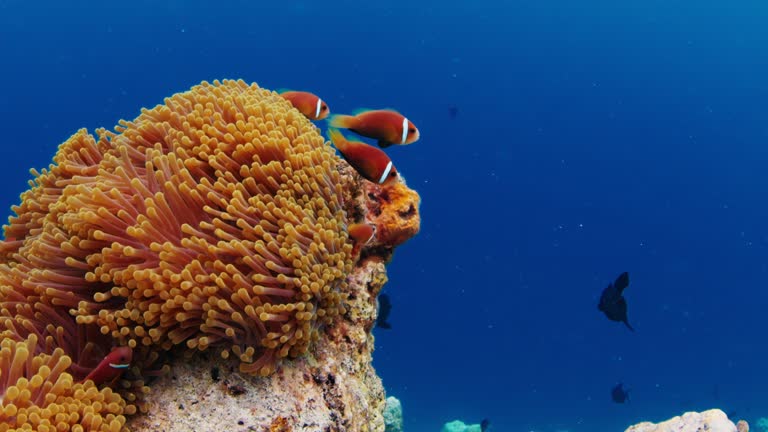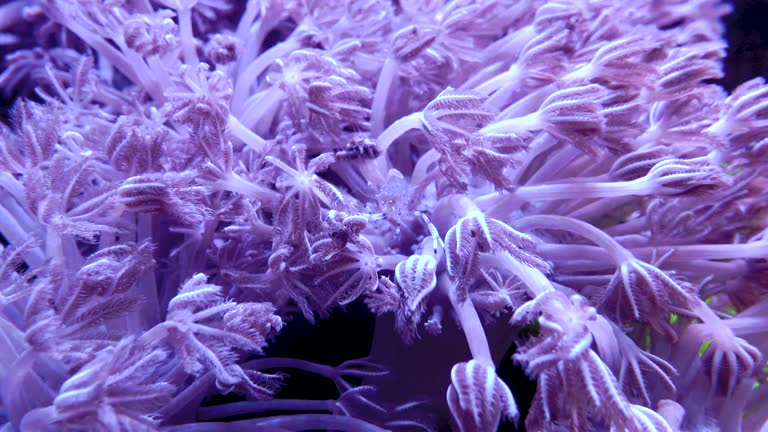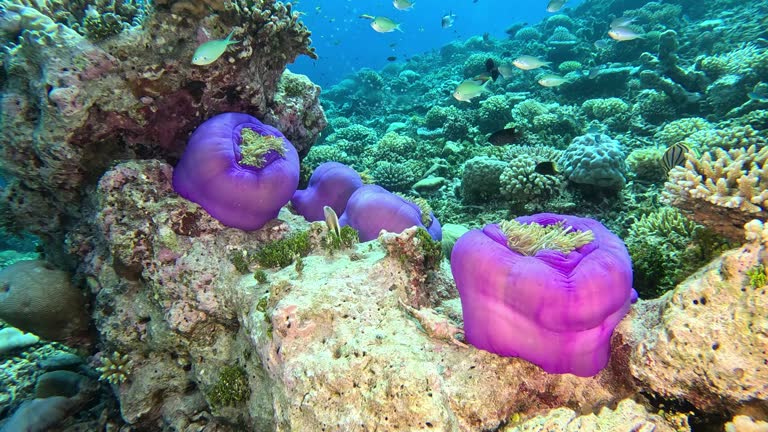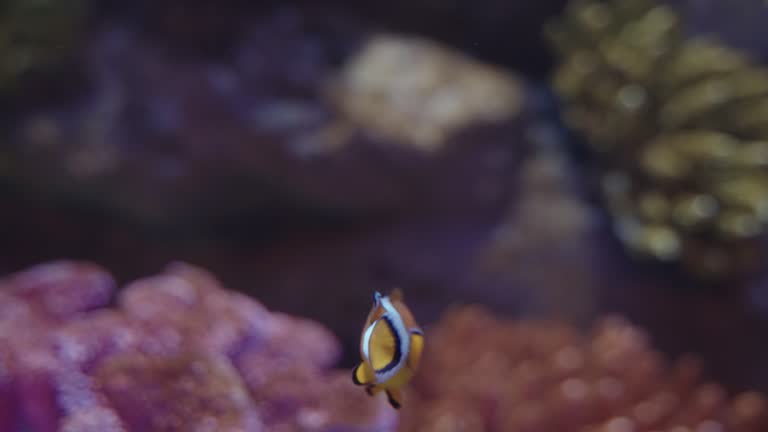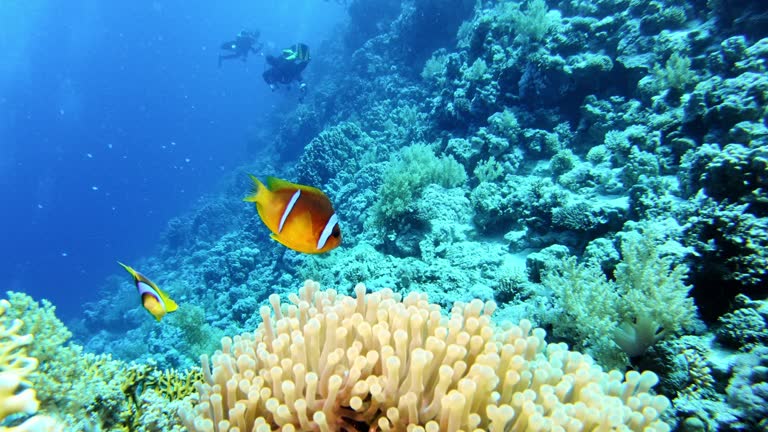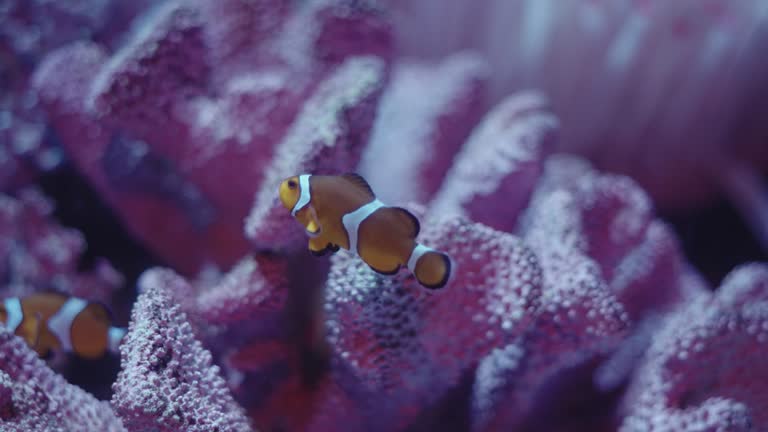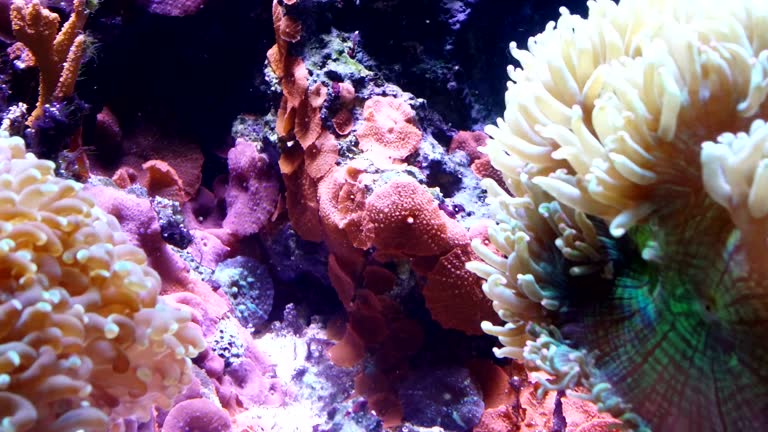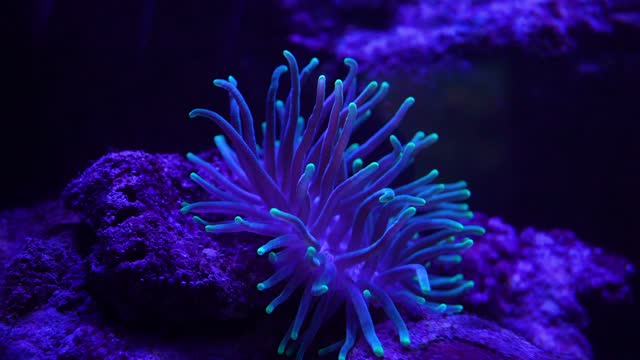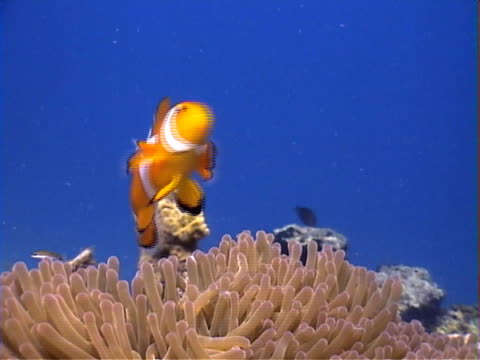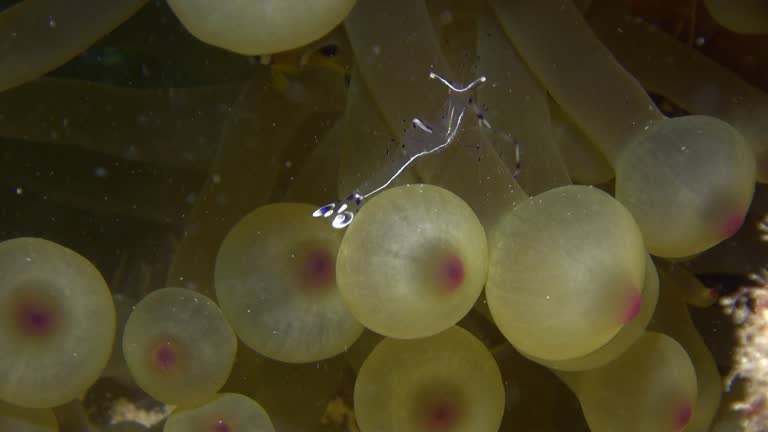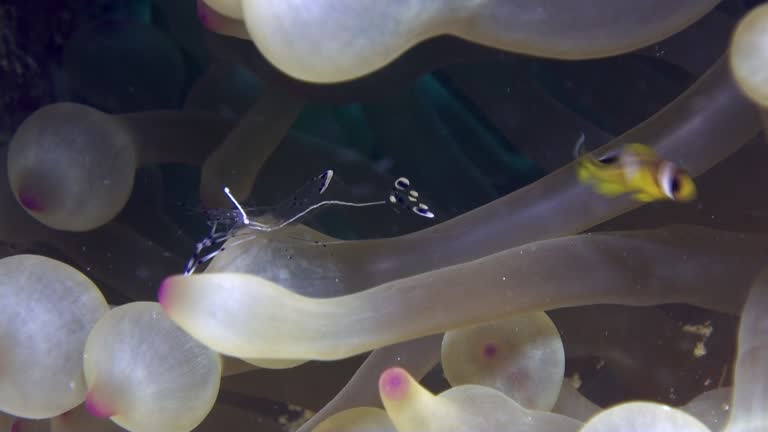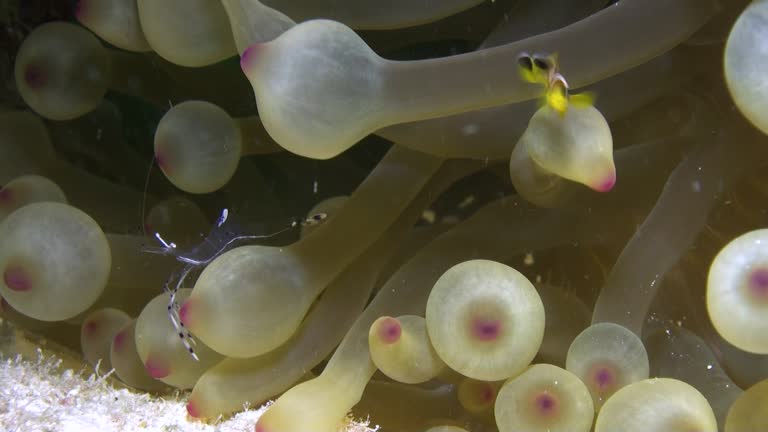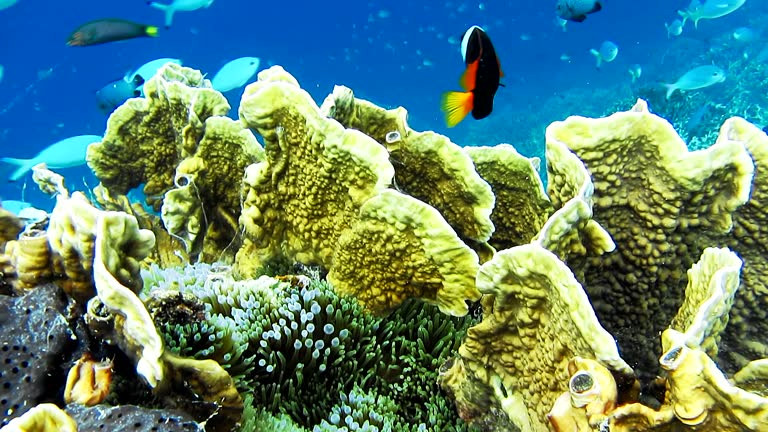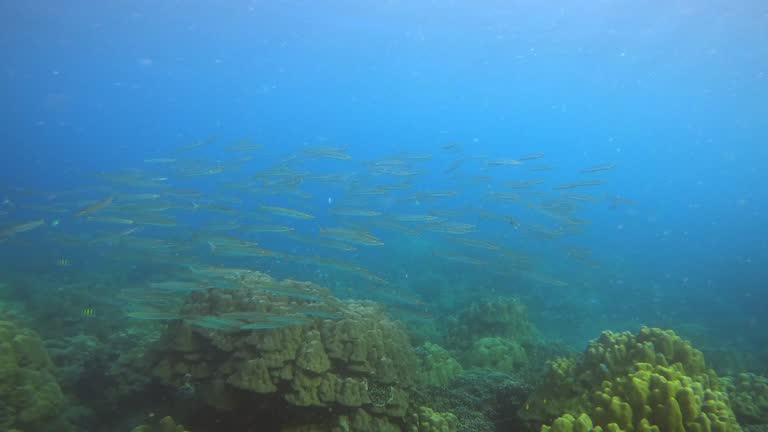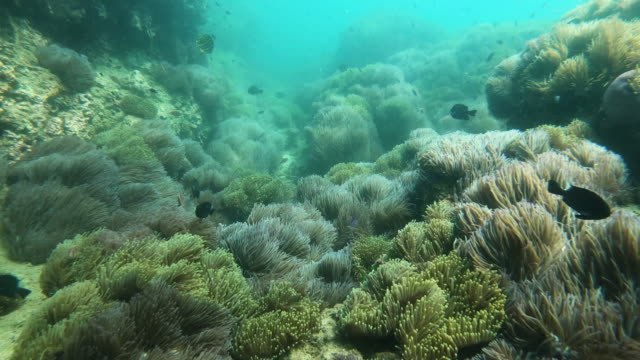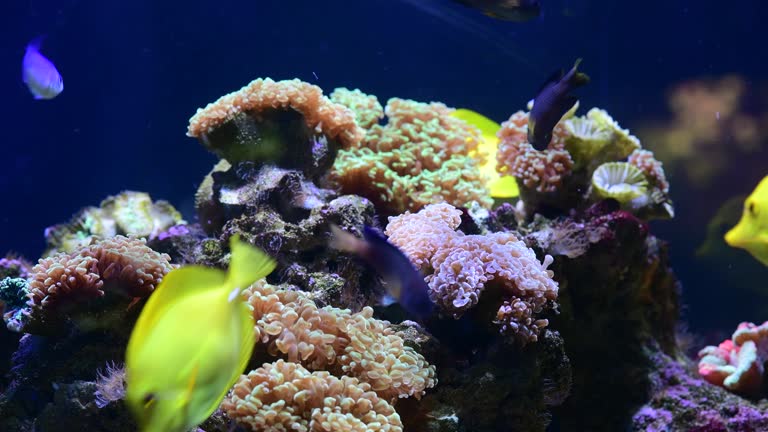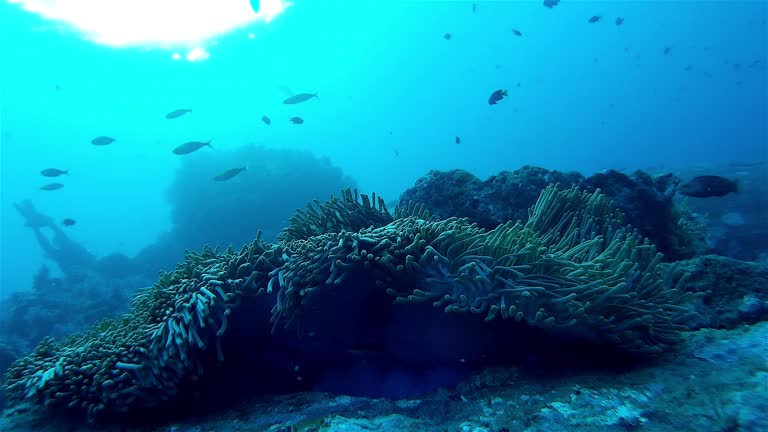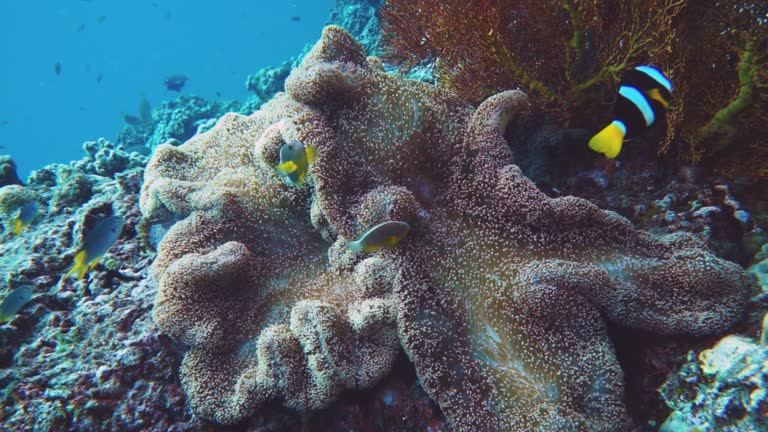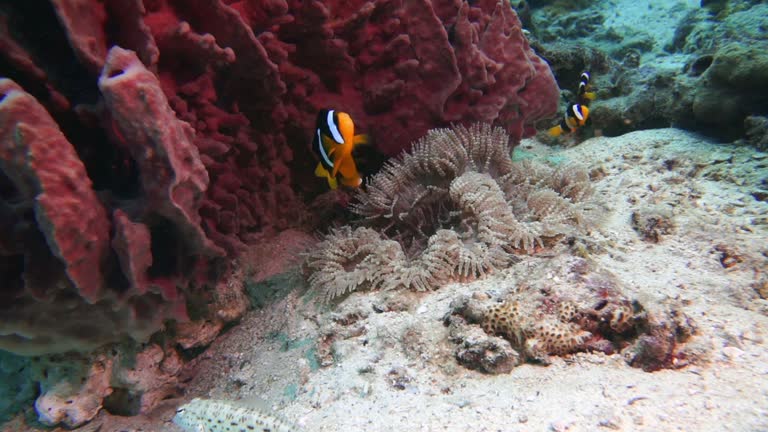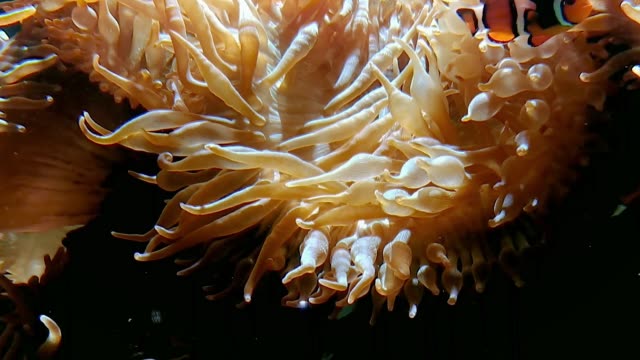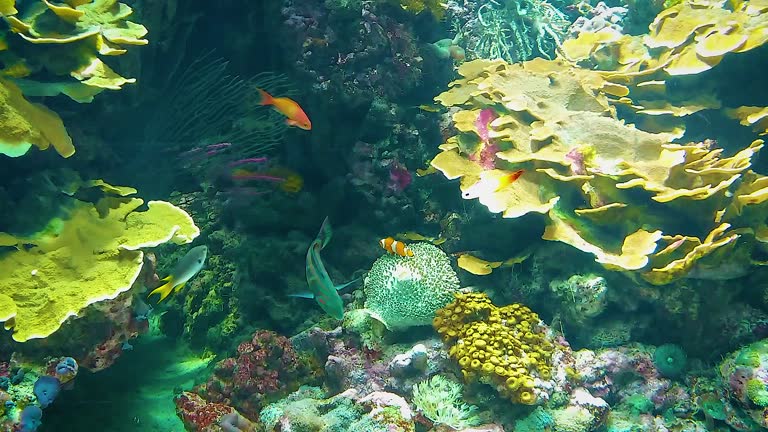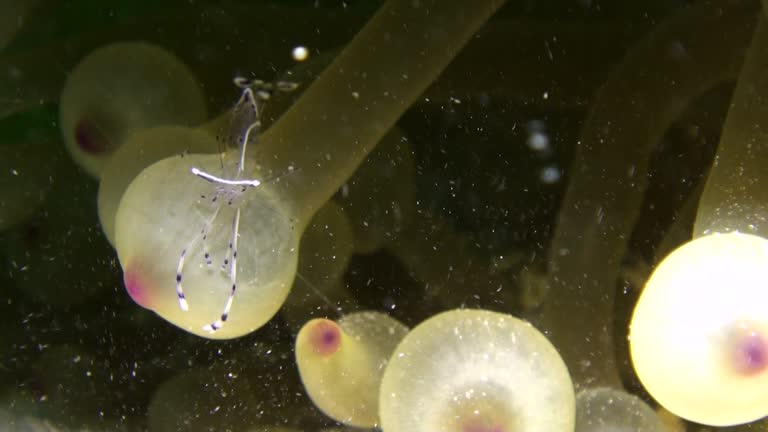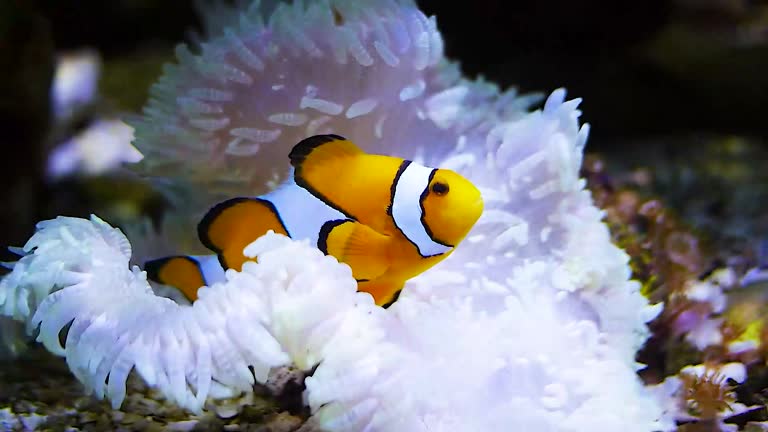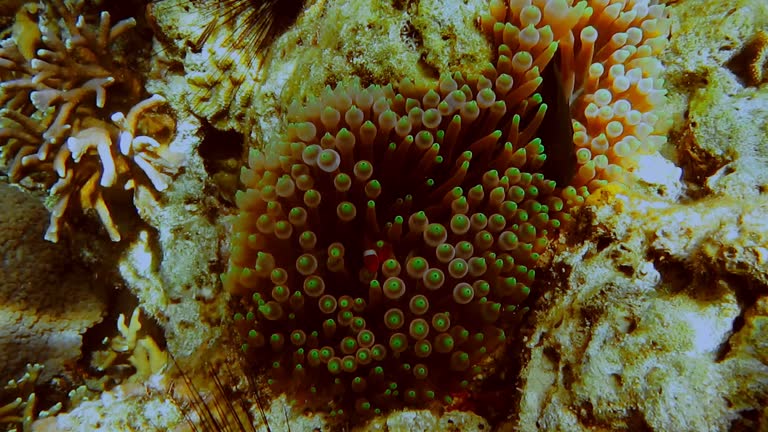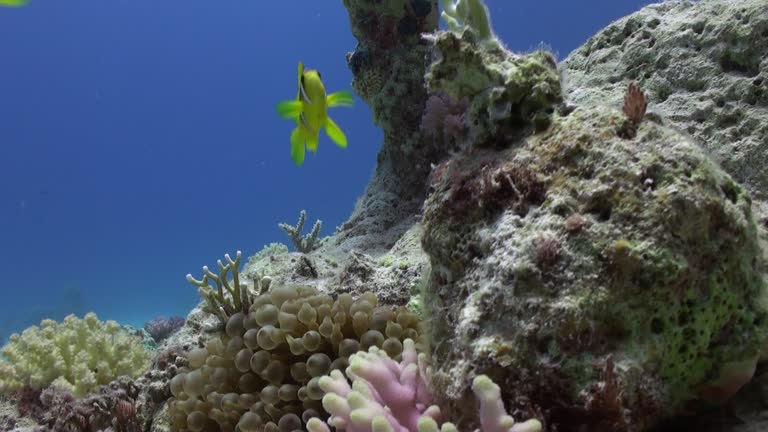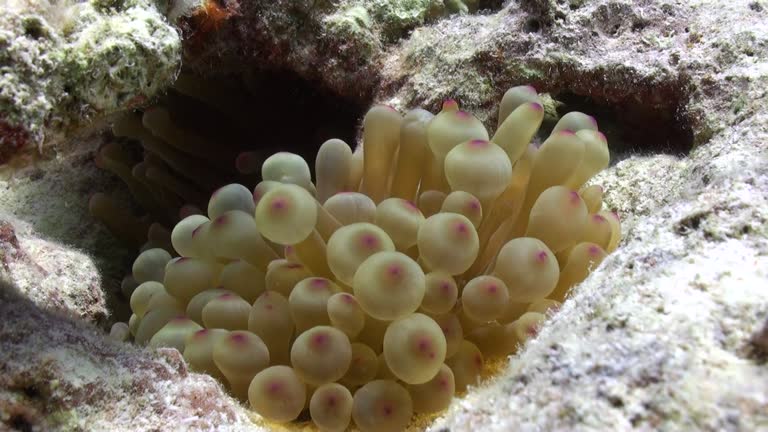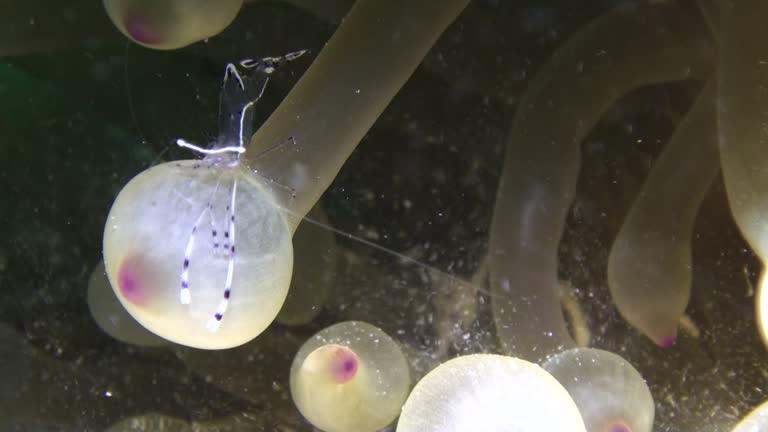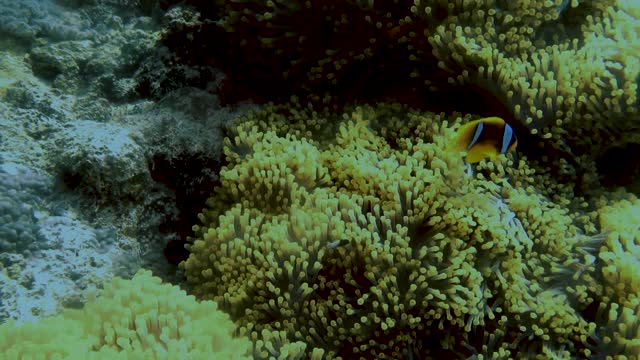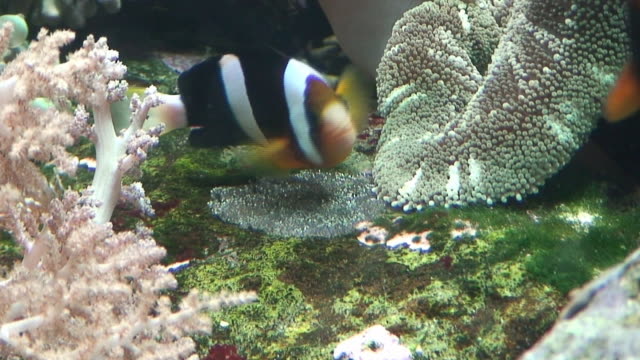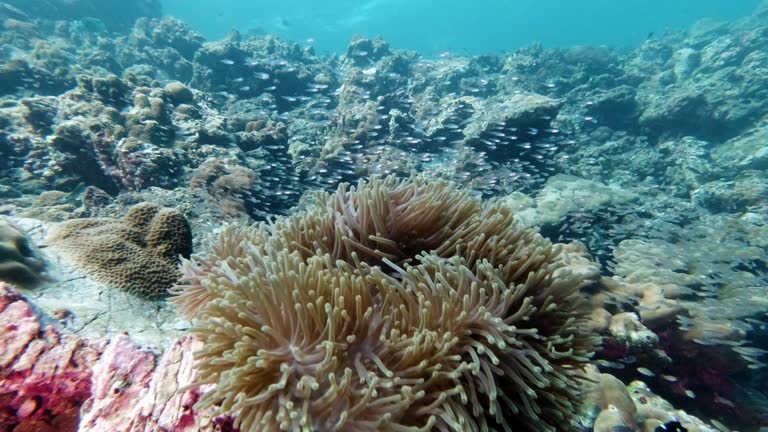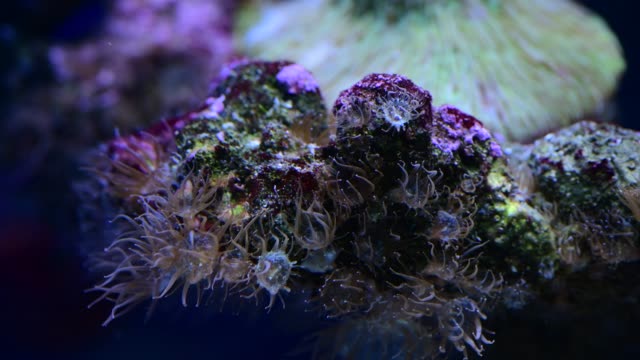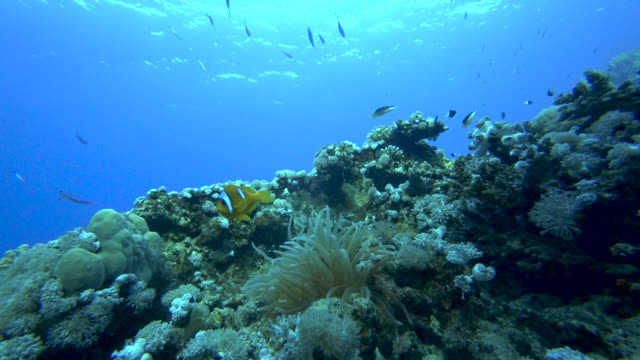
Reef Sea Anemone Anemonefish Anemone Flower stock videos and footage
Browse 530+ reef sea anemone anemonefish anemone flower stock videos and clips available to use in your projects, or start a new search to explore more stock footage and b-roll video clips.

Tropical fish under water
Clownfish or amphiprion surrounded by sea anemones
Clownfish (Amphiprioninae) hiding among anemone coral tentacles
Beautiful Box jellyfish in deep sea life
Clownfish (Amphiprioninae) hiding among anemone coral tentacles
Small orange clown fish Amphiprion swims and plays in blue water. Underwater shooting
Beautiful anemone and fish on a coral reef.
Beautiful anemone and fish on a coral reef.
Coral reefs are the one of earths most complex ecosystems, containing over 800 species of corals and one million animal and plant species. Here we see a shallow coral reef consisting of a Magnificent Anemone (Heteractis magnifica) with Skunk Anemonefish (Amphiprion ephippium) Clownfish. The Anemone has stinging venom coated polyps, which the Anemonefish has the ability to cover its body with and use as protection from predators. In return, the Anemonefish constantly eats parasites from the Anemone, keeping it clean. A perfect demonstration of a symbiotic relationship in nature.
Magnificent sea Anemone (Heteractis magnifica) aka Ritteri anemone colonise this healthy underwater coral reef. When open these flared out Cnidarian discs reveal vast amounts of stinging tentacles used to stun and consume it’s prey. The tentacles also fascilitate photosynthesis of its symbiotic zooxanthellae, a second means of eating. The Anemone maintain a symbiotic relationship with the Skunk Anemone Clown fish (Amphiprion ephippium) as seen here. Footage taken whilst scuba diving at Koh Haa island archipelago, Andaman sea, Krabi province, Thailand, which is one of Thailand’s best dive sites.
Clownfish (Amphiprioninae) hiding among anemone coral tentacles
The Video record Flower-like sea animal on stone beside in sea.
A Skunk Anemonefish Clown fish (Amphiprion ephippium) is in a Magnificent Sea Anemone (Heteractis magnifica). Coral reefs are the one of earths most complex ecosystems, containing over 800 species of corals and one million animal and plant species. The Anemone has stinging venom coated polyps, which the Anemone fish has the ability to cover its body with and use as protection from predators. The Anemone fish eats parasites from the Anemone, keeping it clean. A perfect demonstration of a symbiotic relationship in nature. The location is Phi Phi, Andaman Sea, Krabi, Thailand.
This underwater Merten’s Anemone (Stichodactyla mertensii) is home to several species of tropical fish on this coral reef. Numerous Three spot Dascyllus Damsel fish (Dascyllus carneus) and one Skunk Anemonefish (Amphiprion akallopisos) live within this coral having a symbiotic relationship with it. Footage taken whilst scuba diving at Phi Phi island archipelago, Krabi province, Thailand.
Beautiful deep sea life underwater fish and sea anemone
Giant White-Plumed Anemone swaying in streams of water close-up on a black background. Giant Anemone isolated on a dark background. Moving sea anemone. Motion of beautiful giant plumose anemone.
Giant White-Plumed Anemone lives on the rocks at the bottom of the sea. In the early plan, fish swims. Giant anemones against the background of the seabed in the reef. Movement of the sea anemone.
4k Beautiful colourful of Nemo fish and anemone flower undersea with sunlight, Location at Andaman Sea, Koh Lipe, Thailand
Giant White-Plumed Anemone lives on the rocks at the bottom of the sea. In the early plan, fish swims. Giant anemones against the background of the seabed in the reef. Giant Anemone isolated on a dark background.
Wild nemo clownfish family in sea anemone at Koh Surin, Thailand
False Clown fish family known as nemo fish on pink-green Anemone.
False Clown fish family known as nemo fish on pink-green Anemone.
Sea anemones are a group of predatory marine invertebrates of the order Actiniaria. Because of their colourful appearance, they are named after the Anemone, a terrestrial flowering plant. Sea anemones are classified in the phylum Cnidaria, class Anthozoa, subclass Hexacorallia. As cnidarians, sea anemones are related to corals, jellyfish, tube-dwelling anemones, and Hydra. Unlike jellyfish, sea anemones do not have a medusa stage in their life cycle. A typical sea anemone is a single polyp attached to a hard surface by its base, but some species live in soft sediment, and a few float near the surface of the water. The polyp has a columnar trunk topped by an oral disc with a ring of tentacles and a central mouth. The tentacles can be retracted inside the body cavity or expanded to catch passing prey.[clarification needed] They are armed with cnidocytes (stinging cells). In many species, additional nourishment comes from a symbiotic relationship with single-celled dinoflagellates, with zooxanthellae, or with green algae, zoochlorellae, that live within the cells. Some species of sea anemone live in association with clownfish, hermit crabs, small fish, or other animals to their mutual benefit. Sea anemones breed by liberating sperm and eggs through the mouth into the sea. The resulting fertilized eggs develop into planula larvae which, after being planktonic for a while, settle on the seabed and develop directly into juvenile polyps. Sea anemones also breed asexually, by breaking in half or into smaller pieces which regenerate into polyps. Sea anemones are sometimes kept in reef aquariums; the global trade in marine ornamentals for this purpose is expanding and threatens sea anemone populations in some localities, as the trade depends on collection from the wild.
False Clown fish family known as nemo fish on pink-green Anemone.
Clown fish playing in a living coral.
Coral reefs are the one of earths most complex ecosystems, containing over 800 species of corals and one million animal and plant species. Here we see a shallow coral reef consisting of a Magnificent Anemone (Heteractis magnifica) with Three Spot Dascyllus (Dascyllus trimaculatus) Damselfish. The Anemone has stinging venom coated polyps, which the Damselfish has the ability to cover its body with and use as protection from predators. In return, the Damselfish constantly eats parasites from the Anemone, keeping it clean. A perfect demonstration of a symbiotic relationship in nature. The location is Hin Daeng (Red Rock), Andaman sea, Krabi, Thailand.
Tiny coral shrimp on Xenia soft coral colony and polyp opening and closing the head.
Sea anemones are a group of predatory marine invertebrates of the order Actiniaria. Because of their colourful appearance, they are named after the Anemone, a terrestrial flowering plant. Sea anemones are classified in the phylum Cnidaria, class Anthozoa, subclass Hexacorallia. As cnidarians, sea anemones are related to corals, jellyfish, tube-dwelling anemones, and Hydra. Unlike jellyfish, sea anemones do not have a medusa stage in their life cycle. A typical sea anemone is a single polyp attached to a hard surface by its base, but some species live in soft sediment, and a few float near the surface of the water. The polyp has a columnar trunk topped by an oral disc with a ring of tentacles and a central mouth. The tentacles can be retracted inside the body cavity or expanded to catch passing prey.[clarification needed] They are armed with cnidocytes (stinging cells). In many species, additional nourishment comes from a symbiotic relationship with single-celled dinoflagellates, with zooxanthellae, or with green algae, zoochlorellae, that live within the cells. Some species of sea anemone live in association with clownfish, hermit crabs, small fish, or other animals to their mutual benefit. Sea anemones breed by liberating sperm and eggs through the mouth into the sea. The resulting fertilized eggs develop into planula larvae which, after being planktonic for a while, settle on the seabed and develop directly into juvenile polyps. Sea anemones also breed asexually, by breaking in half or into smaller pieces which regenerate into polyps. Sea anemones are sometimes kept in reef aquariums; the global trade in marine ornamentals for this purpose is expanding and threatens sea anemone populations in some localities, as the trade depends on collection from the wild.
Clownfish (Amphiprioninae) hiding among anemone coral tentacles
Closed anemone and clownfish close up underwater on seabed of wildlife Maldives. Swimming in world of colorful beautiful corals reefs. Inhabitants in search of food. Abyssal relax diving.
Clown fish playing in a living coral.
The video of the sea anemone. The sea plant has lots of tentacles of blue color. The corals are around the plant. The video was taken in Xcaret park, Mexico
4 shots of different species of clownfish - total 29sec.
Fish on background underwater landscape in Red sea. Swimming in world of colorful beautiful wildlife of reefs and algae. Inhabitants in search of food. Abyssal diving.
Shrimp cleaner and clownfish in anemone underwater in Red sea. Swimming in world of colorful beautiful wildlife of reefs and algae. Inhabitants in search of food. Abyssal diving.
Fish on background underwater landscape in Red sea. Swimming in world of colorful beautiful wildlife of reefs and algae. Inhabitants in search of food. Abyssal diving.
Fish on background underwater landscape in Red sea. Swimming in world of colorful beautiful wildlife of reefs and algae. Inhabitants in search of food. Abyssal diving.
False Clown fish family known as nemo fish on pink-green Anemone.
4k Beautiful colourful of fish and anemone flower undersea
Panning over the underwater view with coral and school of fish
Sea anemone moving under water, nature underwater 4K footage
Underwater shot from Thailand
Coral reefs are the one of earths most complex ecosystems, containing over 800 species of corals and one million animal and plant species. Here we see a shallow coral reef consisting of a Carpet Anemone (Stichodactyla Gigantea) with a Clark’s Anemonefish (Amphiprion Amphiprion clarkii) Clownfish. The Anemone has stinging venom coated polyps, which the Anemonefish has the ability to cover its body with and use as protection from predators. In return, the Anemonefish constantly eats parasites from the Anemone, keeping it clean. A perfect demonstration of a symbiotic relationship in nature. Footage obtained whilst scuba diving at Phi Phi islands, Andaman sea, Krabi, Thailand.
Coral reefs are the one of earths most complex ecosystems, containing over 800 species of corals and one million animal and plant species. Here we see a shallow coral reef consisting of a Beaded Sea Anemone (Heteractis aurora) with a Clark’s Anemonefish (Amphiprion clarkii) Clownfish. The Anemone has stinging venom coated polyps, which the Anemonefish has the ability to cover its body with and use as protection from predators. In return, the Anemonefish constantly eats parasites from the Anemone, keeping it clean. A perfect demonstration of a symbiotic relationship in nature. The location is Phi Phi islands, Andaman sea, Krabi, Thailand. Sony mirrorless camera, with underwater housing and Mares EOS 12rz lighting used.
Fish on background underwater landscape in Red sea. Swimming in world of colorful beautiful wildlife of reefs and algae. Inhabitants in search of food. Abyssal diving.
Fish on background underwater landscape in Red sea. Swimming in world of colorful beautiful wildlife of reefs and algae. Inhabitants in search of food. Abyssal diving.
Fish on background underwater landscape in Red sea. Swimming in world of colorful beautiful wildlife of reefs and algae. Inhabitants in search of food. Abyssal diving.
False Clown fish family known as nemo fish on pink-green Anemone.
Coral reefs are the one of earths most complex ecosystems, containing over 800 species of corals and one million animal and plant species. Several False Clown fish (Amphiprion ocellaris) are within a Magnificent Anemone (Heteractis magnifica). The Clown fish and Anemone have a symbiotic relationship with each one receiving mutual benefit. Footage taken whilst scuba diving in Phi Phi islands, Andaman Sea, Krabi, Thailand.
Underwater shot from Thailand
False Clown fish family known as nemo fish on pink-green Anemone.
Beautiful sea life underwater, group of fish playing enjoy the sea anemone.
4k video footage of clown fish swimming underwater amongst the anemone
Fish on background underwater landscape in Red sea. Swimming in world of colorful beautiful wildlife of reefs and algae. Inhabitants in search of food. Abyssal diving.
Fish on background underwater landscape in Red sea. Swimming in world of colorful beautiful wildlife of reefs and algae. Inhabitants in search of food. Abyssal diving.
Fish on background underwater landscape in Red sea. Swimming in world of colorful beautiful wildlife of reefs and algae. Inhabitants in search of food. Abyssal diving.
Fish on background underwater landscape in Red sea. Swimming in world of colorful beautiful wildlife of reefs and algae. Inhabitants in search of food. Abyssal diving.
Tropical clownfish taking care of his offspring and oxigenating them with extreme care
Magnificent sea Anemone (Heteractis magnifica) aka Ritteri anemone colonise this healthy underwater coral reef. When open these flared out Cnidarian discs reveal vast amounts of stinging tentacles used to stun and consume it’s prey. The tentacles also fascilitate photosynthesis of its symbiotic zooxanthellae, a second means of eating. The Anemone is surrounded by hundreds of small schooling Glass fish. 4k footage taken whilst scuba diving at Koh Haa island archipelago, Andaman sea, Krabi province, Thailand.
Beautiful deep sea life underwater fish and sea Bubble-tip anemone
